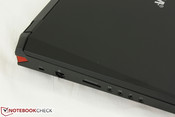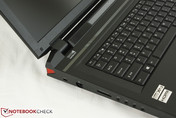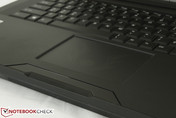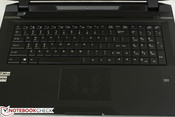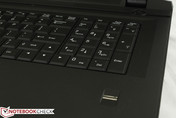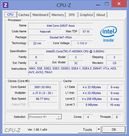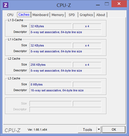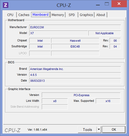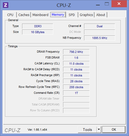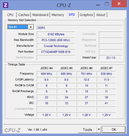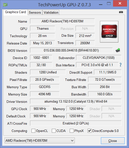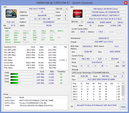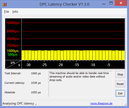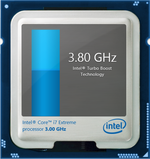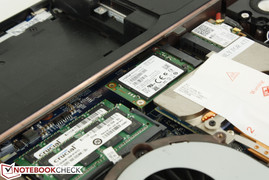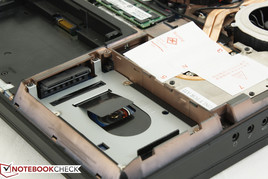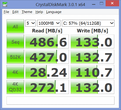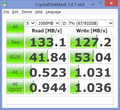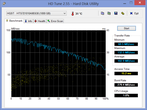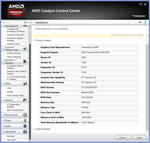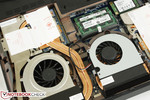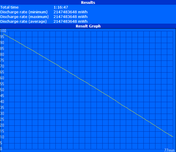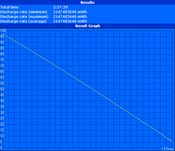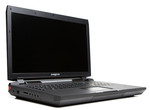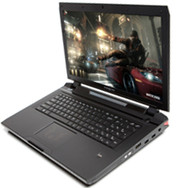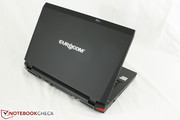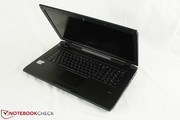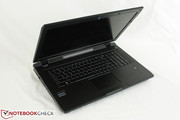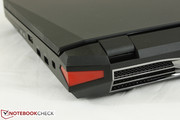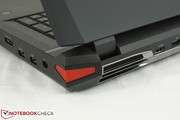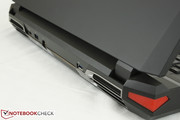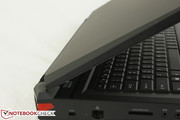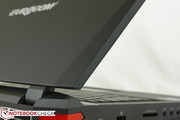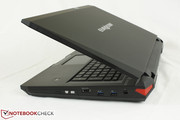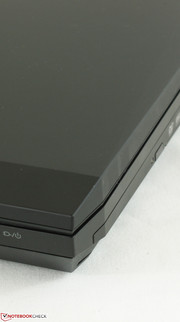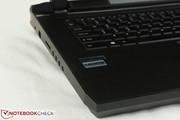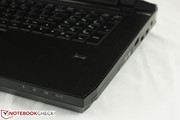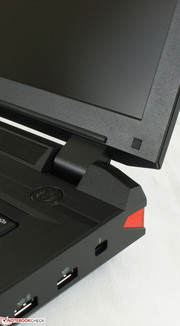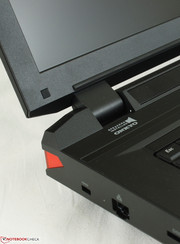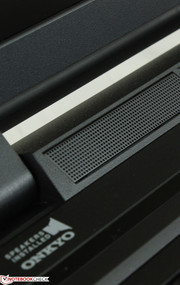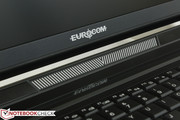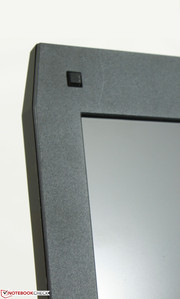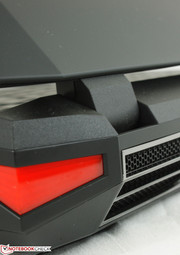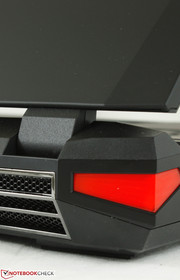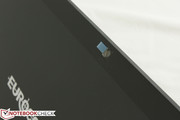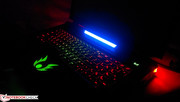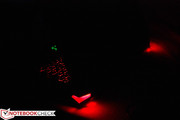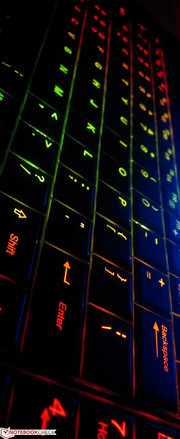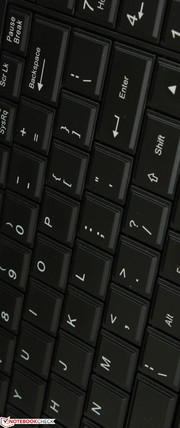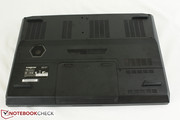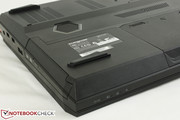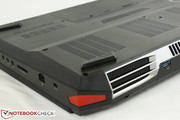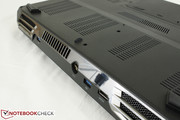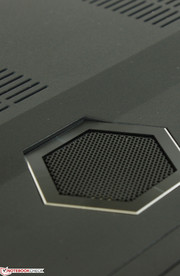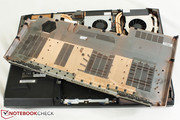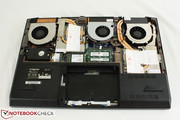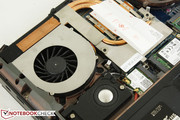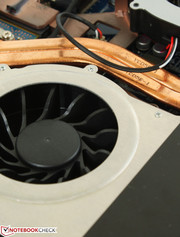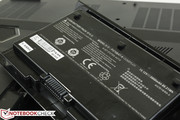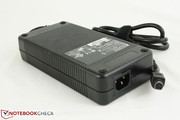Review EUROCOM X7 (Clevo P375SM) Notebook
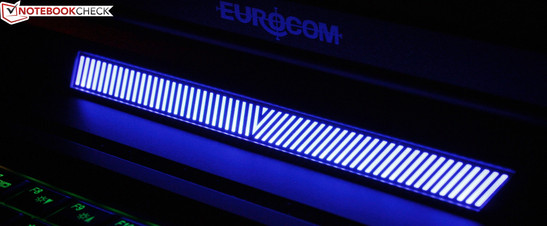
As a well-known reseller of Clevo barebones, Eurocom offers a wider range of ultra high-end options than many bigger name competitors. The range is truly broad from the $899 11.6-inch EUROCOM Monster to the 3D-capable $3999+ 17.3-inch Panther 5D. All models are able to play the most demanding games of today regardless of display size.
The 17.3-inch EUROCOM X7 is the reseller's top-of-the-line offering catered for gamers at a starting price of $1999. Since this is Eurocom we’re talking about here, expect almost all the features and configurable powerful hardware options you can imagine included with the X7. Our review model as configured is equipped with a Core i7-4930MX, Radeon HD 8970M in CrossFireX, 16 GB PC3-12800 DDR3 RAM and a 120 GB SATA III Crucial SSD.
Our last review on a Eurocom left us great impressions because of its extreme system performance, abundant storage options and high quality display. While we have no qualms that the X7 will deliver a similar experience as its smaller brother at the very least, it faces stiffer competition in the larger 17.3-inch category with the likes of the Alienware 17, recently refreshed Asus ROG G750 series and other resellers like the MSI-based Valkyrie CZ-17. Find out below if the X7 stands tall against the rest in this new Haswell generation.
Case
Clevo cases have always been easy to identify. Matte black finishing, flat boxy profile and sharp corners and edges are typical of the chassis series from the Taiwanese OEM. These characteristics make a return on the EUROCOM X7 with extra perks for a more appealing look. The rear ports and ventilation grilles are surrounded by chrome plating and the corners have red LEDs that activate when connected to an AC outlet. The blue lights on the display bezel are another visual flair that double as a sort of equalizer while the emblem on the touchpad is a carryover from the X3. The implementation of these LED embellishments is more than likely to have been influenced by other DTRs or even high-end desktops where such lightshows are expected from gamers. While some users may find the extravagant lights a bit too much, it is certainly more eye-catching than the older and duller Clevo cases that lack these features.
Aside from the addition of new lights, case quality is similar to the X3 and Clevo P370SM, the latter of which is very similar to the X7 in physical features. Users should not expect MIL-STD compliance, but the rough matte base is thick and almost completely resistant to twists and pressure from all sides. Only the center of the keyboard gives way when pressed down with enough force, but the very slight depression is not a cause for concern. In contrast, the smooth and slightly rubberized outer matte lid feels similar to an Asus ROG in texture, but depresses a bit too much when pushed down the center. Even a slight amount of force can result in a very visible warp, especially when compared to other 17.3-inch DTRs like the Valkyrie CZ-17 or Asus G750JW. Side-to-side twisting of the front edges of the lid is also possible though minimal enough to not be worrisome. Even so, we certainly do not recommend placing heavier items on top of the X7 if traveling or otherwise.
With the lid open, the two relatively small hinges and the plastic display bezel become visible. The hinges are able to perform their function well, although they could have been better at its widest angle. For example, the screen at its maximum allowable angle will still vibrate slightly when typing normally, but is otherwise perfectly still at smaller angles. The maximum angle is also a little on the low side at only about 135 degrees. The lid is satisfactory for gaming and otherwise, but leaves room for future improvements. When taken as a whole, we have found no major complaints about the base of the unit.
Connectivity
Physical connectivity options have carried over untouched from the P370SM. This includes the Thunderbolt port, eSATA, 4x 3.5 mm audio jacks and HDMI 1.4. The thickness and size of the notebook allow for easy access to all of the ports. The left hand side, however, lacks any USB ports despite having a total of 5x USB ports around the notebook. The placement of these ports is unsurprisingly optimized for right-handed users.
Note that there is no VGA port, so legacy displays are left out of the cold without an adapter. This is compared to the G750JW, Qosmio X70 or MSI GX70 where VGA-out is present on all models. The manufacturer has clearly weighed the potential of the included Thunderbolt port against the axed VGA port to give the X7 longer legs and more compatibility with future devices. Note that the port is also backwards compatible with Mini DisplayPort 1.2 devices as they share the same connector.
Communication
Wireless connectivity is provided by a dual-band (2x2) Intel Wireless-AC 7260 with support for Bluetooth 4.0, a, b, g, n and ac standards. Its maximum theoretical transfer rate is rated at 867 Mbps with an ac connection and both bands active (2.4 GHz and 5 GHz), otherwise it will top out at the standard 300 mbps with wireless-n. Users with no interest in ac can configure more standard WLAN wireless-n cards. We ran into no connectivity issues or random dropouts when connecting to a standard WPA2 home network. Note that there is no native support for WWAN or GPS, both of which are more common amongst business-centric notebooks.
Maintenance
The main maintenance hatch on the belly of the unit provides direct access to nearly all components including both MXM 3.0b GPU slots, all three system fans, CPU, one of the mSATA slots, 2x SODIMM RAM slots and the half-mini PCIe WLAN card. Popping off the cover only involves loosening four Philips screws for quick end-user changes as needed. Such a trait is commonly shared between most DTRs with the Asus ROG series being a notable exception. Even so, the X7 allows for more expandability options than much of the competition with its 5x drive bays (2x mSATA SATA III, 2x 2.5-inch SATA III, 1x ODD SATA II) and 4x RAM slots.
Note that a number of internal features can only be accessed via a smaller secondary hatch or after removal of the keyboard. The former is simple to remove and exposes both 2.5-inch SATA bays while the latter will require a sharp edge and some careful hands in order to reach the second mSATA slot and two of the RAM slots. Many MSI DTRs are similar in that a few key components can only be accessed underneath the keyboard. For more detailed pictures on how to disassemble the keyboard on the X7, see our review on the Clevo P370SM. In general, Clevo cases do allow for easier tinkering relative to other barebones and especially proprietary cases.
Accessories
Out-of-the-box accessories include additional screws and caddies for 2.5-inch drives and a handy cleaning cloth. A CyberLink Media software disc and drivers disc are also included and they are both quite important as the X7 ships with a bare Windows 8 OS. Optional accessories are made up of third-party hardware or generic externals like USB hubs, adapters and styluses since the X7 lacks a dedicated docking port.
Warranty
The standard one-year warranty applies here for U.S. buyers with free tech-support. Users can extend coverage up to two years or three years for $151 or $271, respectively. Although not as extensive as say coverage from Dell, the options are much more straightforward and clear-cut as a result.
Input Devices
Keyboard
The full-size (35.25 cm x 10.75 cm) keyboard is identical to that of the P370SM. More information on our thoughts about the keyboard can be seen in the Schenker review, but the overall travel and responsiveness are both quiet and reliable. The positioning of the touchpad, however, makes it practically impossible to type without accidentally clicking or moving the mouse, which can be quite the annoyance if the touchpad is not first disabled either manually or by an automatic setting. The small Enter key could have been bigger and the beveled layout can also make the keys feel somewhat cramped compared to a more spacious Chiclet style. Regardless of the minor complaints, we found it easy to become accustomed to the feel and layout of the X7 – we only wish it had dedicated volume and brightness keys for quick adjustments on the fly.
Touchpad
The poorly designed integrated touchpad of the P370SM has been redone on the X7 – and for the better. The moderately sized touchpad surface (10.5 cm x 7 cm) is no longer physically clickable on the Eurocom, which was the heart of the issue on the aforementioned Clevo. The surface, though smaller in area than the trackpad on an Asus G750, is rigid enough to resist a firm push with a finger. The Sentelic software allows the pad to recognize up to 4-finger inputs with many customizable gestures. Zooming feels slightly on the laggy side, but two-finger scrolling and simple pointing-and-clicking are otherwise smooth and responsive with no random cursor jumps or other issues.
With the left and right click keys no longer integrated onto the touchpad, a dedicated pair of click keys is the only other solution. The textured narrow bar below the touchpad is this set of keys and it unfortunately disappoints. Travel is extremely shallow with soft feedback. Quiet clicks are the end result, but it certainly does not make up for the poor feel of the keys. Furthermore, clicking the right half of the bar feels softer than the left half, leading to a somewhat odd asymmetric feel. Thankfully, most users will have access to an external mouse for all intents and purposes, so these keys are not likely to see extended use and can be ignored for the most part.
Display
A matte 1920 x 1080 resolution screen from AUO graces our 17.3-inch display. According to its B173HW01 model number, the same matte panel can be found on the DevilTech Fragbook, HellMachine, and other Clevo barebones including the P370EM and P570WM. Texts and images appear sharp with no blurring, color noise or other oddities like we experienced on the Asus G750JW.
Brightness and contrast are rated at 300 cd/m2 and 500:1, respectively. With a measured average brightness of 299.5 nits, we can certainly confirm with our own instruments that the backlight is indeed as advertised, though contrast could use a little improvement as it is below competing 17.3-inch DTRs. Black can be a little muddy and gray in texture during movie playback, which is acceptable for a lower-cost notebook but can be better for a high-end multimedia powerhouse.
| |||||||||||||||||||||||||
Brightness Distribution: 85 %
Center on Battery: 295.4 cd/m²
Contrast: 369:1 (Black: 0.8 cd/m²)
ΔE ColorChecker Calman: 3.32 | ∀{0.5-29.43 Ø4.79}
ΔE Greyscale Calman: 4.21 | ∀{0.09-98 Ø5}
66% AdobeRGB 1998 (Argyll 1.6.3 3D)
69.7% AdobeRGB 1998 (Argyll 3D)
95.2% sRGB (Argyll 3D)
68.3% Display P3 (Argyll 3D)
Gamma: 2.4
CCT: 7190 K
Color space coverage is about 60 percent of the AdobeRGB spectrum or over 95 percent of the smaller sRGB spectrum. Users can even opt for a glossy option rated for 90 percent of the NTSC color space for an additional $40. For gamers, however, the base option like we have here will suffice as the wider color gamut is mostly of interest for graphic designers and other professionals where color accuracy is vital. This matte option is already leagues above cheaper displays where color space coverage is typically around 60 percent of sRGB. Colors are subjectively vibrant with no screen door effect from a normal viewing distance.
Display performance is analyzed further with an X-Rite i1Basic Pro 2 spectrophotometer. Without any calibration, almost all colors show a deltaE 2000 deviation of more than 10 units, though this does generally get better the more saturated the colors become. Post calibration shows significant improvements across the board with a flatter RGB balance, reduced blue overtones and greatly improved grayscale and average color performance. Yellow balance could still use a little improvement compared to other colors, though this is extremely minor. Eurocom does include a $40 option to ship a calibrated .ICC profile via CD and this may be worth the extra dollars for some users if they want the display to be as accurate as possible. However, we repeat ourselves here that such color accuracy is not tangibly valuable to most gamers.

The matte display and good maximum brightness allow for acceptable outdoor usability. Viewability will quickly degrade when under direct sunlight, so shade is highly recommended if outdoor use is unavoidable. As most users are probably expecting, this 17.3-inch powerhouse was made primarily as an indoor notebook and should be spending most of its time indoors.
Viewing angle stability is wide horizontally and is sufficient for the sole user or a handful of viewers. The screen, however, is still a TN panel, so vertical angles above the center normal are still poor compared to IPS-type displays. Relative screen brightness will also decrease slightly if not viewing straight on, but again this should not be a major issue.
Performance
The X7 in review is equipped with a 3 GHz Core i7-4930MX with a theoretical Turbo Boost potential up to 3.7 GHz for all four cores. If on Power Saver mode, the CPU will operate at just 800 MHz. This is the successor to the Ivy Bridge i7-3940XM, otherwise known as the fastest quad-core processor of its generation. Subsequently, the Haswell CPU is the highest available option for the X7, though users can opt for less costly CPUs including the i7-4700MQ, i7-4800MQ or i7-4900MQ. Note that core features of the i7-4930MX are identical to the i7-3940XM including an equal clock rate (3.0 GHz) and L1, L2 and L3 cache sizes. More information and benchmarks on the i7-4930MX can be seen on our dedicated page here.
RAM is provided by two 8 GB PC3-12800 Crucial modules and is configurable up to 32 GB with four modules total. DPC Latency shows no recurring high latency spikes even with wireless radios active. This is to be expected since the X7 ships with a clean Windows 8 install.
Processor
CPU-oriented benchmarks place the X7 in the same ballpark as our EUROCOM X3 and Alienware 18 review models, both of which sport the same i7-4930MX processor. Its single-threaded performance in Super Pi is about 3 percent higher than the high-end desktop Core i7-4770K while its multi-threaded performance in wPrime is about 5 percent slower than the FX-8350, one of AMD’s fastest Vishera-class CPU for desktops.
Compared to the average i7-3940XM, however, the newer Haswell chip is essentially equal in wPrime 1024m (219 seconds vs. 223 seconds), Super Pi 32M (525 seconds vs. 528 seconds) and X264 HD Pass 2 (42.1 seconds vs. 42.6 seconds) benchmarks. This similarity in performance is unsurprising given the equal specs of both CPUs and that much of the Haswell architecture was made to increase iGPU performance rather than raw CPU power.
System Performance
The final PCMark 7 score of 5383 points places the X7 amongst other heavy hitters that either also have powerful CPU and GPU combos or have high-end SSDs in RAID 0. As an example, the Eurocom outscores the Alienware M18x R2 by dozens of points and is below the One K73-3S again by dozens of points in the same benchmark. Both competing models run CrossFireX solutions with one of the fastest mobile CPUs from Intel. While our configured model only makes use of one mSATA SSD, users who choose to run two SATA III SSDs in RAID 0 will see PCMark scores rocket to even higher levels.
Similarly, PCMark 8 shows very high results. Its Home and Work scores are one of the highest in our database, though the X7 has much less competition here due to the very recent addition of this benchmark in our reviews. The Windows 8 Experience scores also demonstrate a very balanced system between the CPU, GPU, RAM and SSD, so no key component in our configuration can be labeled as a major bottleneck. Subjectively, the system runs as smooth as silk at essentially all times.
| PCMark 7 Score | 5383 points | |
| PCMark 8 Home Score Accelerated | 4921 points | |
| PCMark 8 Creative Score Accelerated | 4509 points | |
| PCMark 8 Work Score Accelerated | 4875 points | |
Help | ||
Storage Devices
Up to five storage drives can be installed on the X7 as stated earlier in the review. Drives of the same slot type can be configured in RAID 0/1/5/10 if so desired. Our particular model uses a primary 120 GB Crucial CT120M500SSD3 mSATA drive and a secondary 9.5 mm 1 TB Hitachi Travelstar 7K1000 HTS721010A9E630. The Crucial drive shows typical SATA III SSD sequential read rates of nearly 500 MB/sec in CrystalDiskMark with slow 512K write speeds that are similar to the previous generation Intel SSD 320 Series. 4K write, however, is surprisingly high at 110.7 MB/sec, so small data blocks should handle better than average.
The 7200 RPM Hitachi HDD isn’t nearly as fast, of course, but its average transfer rate of 102.9 MB/sec in HD Tune already puts it above most 2.5-inch mechanical drives where 80 to 90 MB/sec is normal. The 5400 RPM Seagate in our Asus G750JW model, for example, returns 85 MB/sec in the same benchmark with a slower access time of 17.4 ms. See here for our growing benchmarks comparison table of HDDs and SSDs.
Graphics
Dual Radeon HD 8970M GPUs in CrossFireX running BIOS version 015.036.000.005 and driver 13.152.0.0 power our X7 model. As the most powerful AMD offering to date, the scores in synthetic benchmarks are naturally one of the highest in our database. Eurocom does offer plenty of other GPU options – including those from Nvidia – if users prefer the GTX 7xxM Kepler class of GPUs over AMD’s GCN series. Quadrio K1000M up to K5000M GPUs are available as well for workstation users.
We note here that our configured X7 model lacks Enduro. This may have been a smart move considering that AMD drivers are still not up to par with Nvidia and that older systems with Enduro (such as Eurocom's own Racer 2.0) experienced reduced performance from their dGPUs due to AMD’s graphics switching solution. The integrated GPU appears to be disabled to circumvent any potential Enduro related issues entirely.
Both 8970M cores fluctuate between 850 and 900 MHz core clock rate when active according to GPU-Z, which is exactly as rated according to AMD’s own Catalyst 13.9. On the other hand, memory is a steady 1250 MHz. If idling or on Power Saver mode, both the core and memory will run at 300/150 MHz to reduce power consumption. For more information and benchmarks on the 8970M CrossFireX, see our dedicated page here.
3DMark scores are nearly unmatched. In 3DMark 11, for example, the X7 returns a final score of 10997 points – slightly higher than the similarly equipped One K73-3S and only beaten by the recently reviewed 18.4-inch Alienware 18 with its dual GTX 780M and final score of 11960 points. In other words, this Eurocom would have had the highest 3DMark 11 score in our database if it were not for Nvidia’s recently refreshed 7xxM Kepler series. The other closest competing GeForce GPU, the GTX 680M SLI in our Schenker XMG U702, scores about 700 points less than our Radeon-equipped X7 in the same benchmark.
Meanwhile, the notebook’s 3DMark 2013 scores are again one of the highest in our database. With a 3DMark Fire Strike Extreme score of 4212 points, it is second to none – even the desktop GTX 680 and Core i7-2600K score “only” 3049 points in the same benchmark.
| 3DMark 06 Standard Score | 27472 points | |
| 3DMark Vantage P Result | 34941 points | |
| 3DMark 11 Performance | 10997 points | |
| 3DMark Ice Storm Standard Score | 147389 points | |
| 3DMark Cloud Gate Standard Score | 22905 points | |
| 3DMark Fire Strike Score | 8049 points | |
| 3DMark Fire Strike Extreme Score | 4212 points | |
Help | ||
Gaming Performance
Nearly all tested games are playable at 1080p60 with all graphical settings on maximum. The notable exceptions are Guild Wars 2 and Company of Heroes 2, both of which are extremely demanding of the GPU. Problems with the latter title are further compounded by its exceptionally poor support for SLI and CrossFireX as even a single HD 7970M can run the title at maximum 1080p settings at 22 FPS versus just 23 FPS on our dual-GPU setup. Supersampling in Guild Wars 2 is also one of the most taxing features as the supersized buffers suck up much of the bandwidth.
Compared to single GPU setups, the dual Radeon cards outclass even the GTX 780M by as much as 100 percent in some titles. Battlefield 3 and Sleeping Dogs on maximum settings, for example, run at 102 FPS and 62 FPS on the X7, respectively, while the average GTX 780M will run these titles at just 49 FPS and 31 FPS according to our database. Other titles like Metro: Last Light show much less of an improvement or in the case of Guild Wars 2, almost no improvement at all.
Gaming performance is more mixed when compared to systems with a GTX 680M SLI setup. Guild Wars 2 and Battlefield 3, for example, perform better on a Clevo P370EM with Nvidia equivalent hardware while Sleeping Dogs continue to favor the AMD cards by a wide margin. Though the raw FPS numbers aren’t impressive across the board over a similar GTX 680M SLI system, the AMD cards still win the power-per-cost battle.
As for micro stuttering, the phenomenon is barely perceptible as it manifests itself most significantly at lower frame rates. With nearly all titles well above 30 FPS at maximum settings, X7 owners should not be concerned about micro stutters when playing current titles, at least for now.
| low | med. | high | ultra | |
|---|---|---|---|---|
| Battlefield 3 (2011) | 151 | 142.2 | 102.2 | |
| Darksiders II (2012) | 271 | 116 | ||
| Sleeping Dogs (2012) | 129.7 | 114.5 | 62.6 | |
| Guild Wars 2 (2012) | 39 | 40 | ||
| Dishonored (2012) | 129 | 129 | 128 | |
| Call of Duty: Black Ops 2 (2012) | 249.6 | 219.8 | 152 | |
| Tomb Raider (2013) | 388 | 284.4 | 126.5 | |
| StarCraft II: Heart of the Swarm (2013) | 160.1 | 140.1 | 60.6 | |
| BioShock Infinite (2013) | 172.2 | 166.2 | 87.7 | |
| Metro: Last Light (2013) | 100 | 84.9 | 53.2 | |
| GRID 2 (2013) | 159.4 | 134.8 | 112.7 | |
| Company of Heroes 2 (2013) | 57.4 | 49.3 | 23.2 |
Emissions
System Noise
The system utilizes three fans: one for the CPU and two for the two graphics cards, all with standalone rear exhaust vents and copper heat sinks. No two fans are identical in size despite having two identical graphics cards. The smallest fan in terms of diameter is the 50 mm CPU fan while both GPU fans are 60 mm each. The GPU fan closest to the CPU, however, is notably thicker than the other two.
Fan noise is always audible at a minimum of nearly 40 dB(A) when idling. In comparison, this range is typical of an Ultrabook at its loudest state. If idling on High Performance mode, fan noise will quickly kick up to about 42 dB(A). Light workloads such as browsing, word processing or video playback will thankfully not invoke anything higher than this range. Regardless, these very high idling fan noises are relatively loud even for a DTR when compared to the much less noisy MSI GX70/GS70, Asus G750JW, Qosmio X70 and Alienware M17x under the same idling conditions.
Gaming or other intense CPU and GPU loads will increase fan noise in a stepwise manner from the 40 to 42 dB(A) idling state to a measured 46.7 dB(A), 48.5 dB(A) and then finally to 54.1 dB(A). This very high maximum was only achieved under sustained full stress on both the CPU and GPU, so fan speed will instead hover around 46.7 dB(A) when gaming. Though noisy, the high 40 dB(A) range is typical of gaming DTRs and should be expected especially from a dual GPU setup. Its high idling noise, however, could use improvement.
Noise level
| Idle |
| 39.8 / 40.2 / 40.4 dB(A) |
| DVD |
| 42.5 / 48.5 dB(A) |
| Load |
| 46.7 / 54.1 dB(A) |
 | ||
30 dB silent 40 dB(A) audible 50 dB(A) loud |
||
min: | ||
Temperature
With three large and active fans, surface temperatures should hopefully be on the low side. Thankfully this is the case, at least for a bulky DTR with dual GPUs. Idling surface temperatures are more or less uniform across both the bottom and top surfaces with just a few degrees difference when moving towards the rear of the notebook. This confirms our temperature findings on the XMG P723 and One K73-3S, both of which share very similar internals to the X7. The low surface temperatures here during light loads are compared to the Alienware 18 and Asus G750JW where much steeper surface temperature gradients exist under similar conditions.
Running on maximum load resulted in an average temperature rise of about 5 degrees C on both the bottom and top surfaces with the warmest areas reaching about 41 degrees C. This is again quite low and even lower than some very thin Ultrabooks with inferior specs like the Vaio Pro 13 or ThinkPad X1 Carbon. Compared to Asus ROG or MSI models that only use single or double fans, the triple fan and heat sink setup on the X7 pays off with lower temperatures across the board. This same conclusion was drawn on the Alienware 18, XMG P723 and One K73-3S.
(±) The maximum temperature on the upper side is 41.6 °C / 107 F, compared to the average of 40.5 °C / 105 F, ranging from 21.2 to 68.8 °C for the class Gaming.
(±) The bottom heats up to a maximum of 41.2 °C / 106 F, compared to the average of 43.3 °C / 110 F
(+) In idle usage, the average temperature for the upper side is 28.8 °C / 84 F, compared to the device average of 33.9 °C / 93 F.
(+) The palmrests and touchpad are cooler than skin temperature with a maximum of 30.6 °C / 87.1 F and are therefore cool to the touch.
(±) The average temperature of the palmrest area of similar devices was 28.9 °C / 84 F (-1.7 °C / -3.1 F).
Stress Test
We use Prime95 and FurMark to stress the X7 with HWiNFO, CPU-Z and GPU-Z monitoring tools active in order to identify stability or throttling issues, if any. The system was set to maximum performance and connected to a power outlet for the duration of these tests.
With only Prime95 active, the i7-4930MX CPU was observed to be operating at a steady 3.4 GHz or 300 MHz less than the Turbo Boost clock rate for 4 active cores. After a few minutes, the core slowly dropped to a fluctuating 3.0 GHz to 3.4 GHz clock rate, but never below its base 3.0 GHz speed. Core temperature jumped to over 90 degrees C in mere seconds immediately after running Prime95.
With only FurMark active, the GPU was observed to be operating at a steady 850/1250 MHz for the core/memory according to GPU-Z. GPU Clock rates never dipped or increased while the GPU cores themselves topped out at 88 degrees C.
When both Prime95 and FurMark are active, system noise kicked to full gear (~54 dB(A)) and GPU temperatures actually dropped to a steady 82 degrees while CPU temperatures remained above 90 degrees. GPU clock rates were again unchanged at 850/1250 MHz, but CPU speeds were observed to be fluctuating between 3.0 GHz and 3.1 GHz. Very rarely did the CPU drop to 2.8 GHz, and even then for just a very short period of time before bouncing back up to 3 GHz or above. Because of this behavior, HWiNFO recorded throttling characteristics of the CPU. In comparison, the Asus G750JW can sustain its maximum rate without any issues, albeit with a lower-end i7-4700HQ CPU.
Though the X7 does experience very minor throttling, it is so short-lived that users should not feel any ill effects during everyday workloads. A 3DMark 11 benchmark immediately following the stress test resulted in no significant reductions in final GPU or CPU scores (12424 GPU points and 8692 Physics points pre-stress vs. 14073 GPU points and 8496 Physics points post stress).
Running solely on battery power will net much lower 3DMark 11 scores of just 3028 GPU points and 4996 Physics points even on High Performance. The stinted scores can be attributed to the reduced performance of the CPU and GPU when disconnected from an AC source. Both processors will operate at 1.8 GHz and 450/300 MHz, respectively, and not any higher. Having an available AC outlet in reach is highly recommended for any user intending to run demanding applications on the X7.
Speakers
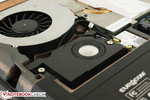
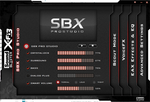
Audio is provided by two 2.2 W ONKYO speakers and one 2.5 W subwoofer underneath the notebook. Like the P370SM before it, the same Sound Blaster X-Fi MB3 software handles the processing and output. The blue light bar in between the two main speakers will pulsate in response to sound, which can be helpful during games as a visual indicator for approaching enemies. It can, however, be a bit too much for basic music and movies and can thankfully be disabled.
Sound quality is otherwise identical and more details can be seen in the related P370SM review. In short, quality is more than satisfactory with plenty of options and filters from the Sound Blaster software. Users with external 5.1 or 7.1 sound systems can connect via the 3.5 mm headphone, S/PDIF or line-in ports.
Battery Life
The X7 is powered by a small-but-dense 5900 mAh (89.21 Wh) 8-cell Li-Ion removable battery. This module is nearly identical to that of the P370SM and is essentially equal in capacity to that of the MSI GX70 (87 Wh), Asus G750JW (88 Wh) and previous generation Alienware 17x (90 Wh). The capacity here is almost twice as much as the recently released Qosmio X70 (46 Wh), which suffers from very short runtimes as a result.
As expected, similar battery capacities between same-size notebooks of differing specifications do not lead to similar runtimes. With an idling (or maximum) runtime of only 3 hours at minimum brightness settings and inactive wireless under the Power Saver profile, the X7 unsurprisingly performs similarly to the P370SM, but is also significantly behind the MSI GX70 (7 hours), Asus G750JW (6.5 hours) and older Alienware M17x R4 (4 hours) under the same settings with the Battery Eater measurement tool. The large discrepancy in runtime can be attributed to the lack of Enduro on the X7, and so battery life will suffer as a result.
WLAN runtimes can be even shorter by up to an hour for about 2 hours of constant use. Despite this, we can’t imagine many users being upset with the battery life if they are considering a DTR of this size and power.
Verdict
Configured with some of the most powerful mobile Haswell and GCN silicon money can buy, it is no surprise that our ~$3300 EUROCOM X7 sits atop a good handful of benchmarks in our database. Our configured model doesn’t even represent its maximum potential; the X7 can be equipped with dual SSDs in RAID 0 or dual GTX 780M GPUs for even higher numbers and an absurd amount of power.
That power comes at a cost – and not just literally – in terms of system noise and battery life. Idling noise could use improvement as competing notebooks of similar size are much quieter during lighter loads like movie playback, browsing or word processing. Battery life is low as well at just two to three hours or at least a couple of hours less than those same competing notebooks and overall performance will indeed drop by a large margin if not connected to an AC outlet. A lower maximum Turbo Boost than advertised under full stress is another drawback, although admittedly a picky criticism. In terms of hardware, the clickpad and outer lid could have offered better usability and rigidity, respectively. There are no options for an IPS/PLS display despite having a choice between glossy and matte.
Buyers who are aware of the drawbacks first will more appreciate what the notebook has to offer. In this case, power users are more likely to be apathetic towards many of the above negatives including battery life, noise or clickpad quality. Performance, longevity and configurability are arguably much more lucrative aspects in this particular DTR category and are without question the best characteristics of the X7.
Appendix
| Battlefield 3 - 1920x1080 ultra AA:4x MS AF:16x (sort by value) | |
| Eurocom X7 | |
| Alienware 18 | |
| One K73-3S | |
| Call of Duty: Black Ops 2 - 1920x1080 (Extra) High / On, FXAA AA:4xMS (sort by value) | |
| Eurocom X7 | |
| Alienware 18 | |
| Schenker XMG U702 | |
| One K73-3S | |
| Darksiders II - 1920x1080 2/4 Shadows, No Ambient Occlusion, AA:Low (sort by value) | |
| Eurocom X7 | |
| Sleeping Dogs - 1920x1080 Extreme Preset AA:Extreme (sort by value) | |
| Eurocom X7 | |
| Alienware 18 | |
| One K73-3S | |
| Guild Wars 2 - 1920x1080 All Maximum / On AA:FX (sort by value) | |
| Eurocom X7 | |
| Alienware 18 | |
| Schenker XMG U702 | |
| One K73-3S | |
| Dishonored - 1920x1080 High / On, FOV: 75 AA:FX (sort by value) | |
| Eurocom X7 | |
| Alienware 18 | |
| Schenker XMG U702 | |
| One K73-3S | |
| Tomb Raider - 1920x1080 Ultra Preset AA:FX AF:16x (sort by value) | |
| Eurocom X7 | |
| Alienware 18 | |
| Asus G750JH-T4080H | |
| One K73-3S | |
| StarCraft II: Heart of the Swarm - 1920x1080 Ultra / Extreme AA:on (sort by value) | |
| Eurocom X7 | |
| BioShock Infinite - 1920x1080 Ultra Preset, DX11 (DDOF) (sort by value) | |
| Eurocom X7 | |
| Alienware 18 | |
| One K73-3S | |
| Metro: Last Light - 1920x1080 Very High (DX11) AF:16x (sort by value) | |
| Eurocom X7 | |
| Alienware 18 | |
| Asus G750JH-T4080H | |
| One K73-3S | |
| GRID 2 - 1920x1080 Ultra Preset AA:4xMS (sort by value) | |
| Eurocom X7 | |
| Alienware 18 | |
| One K73-3S | |
| Company of Heroes 2 - 1920x1080 Maximum / Higher / High AA:High (sort by value) | |
| Eurocom X7 | |
| Alienware 18 | |
| Asus G750JH-T4080H | |
| One K73-3S | |





